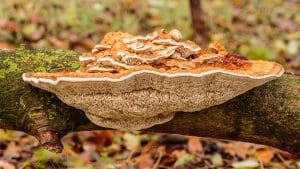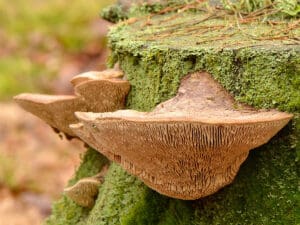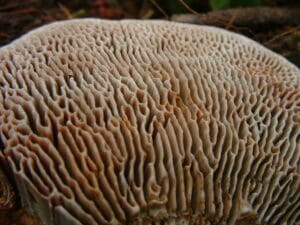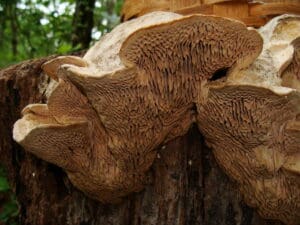Oak Mazegill / Autumn / Summer / Winter / Inedible
One of the joys of walking through ancient woodlands is spotting the fascinating fungi that make their home on old, weathered trees. Among these, the Daedalea quercina, or oak mazegill, stands out as a true marvel of nature.
Clinging to the deadwood of oak trees, this bracket fungus is instantly recognisable by its intricate maze-like underside. Its tough, woody texture might not catch the eye at first, but take a closer look, and you’ll see why it’s such a fascinating species. Its unique patterns seem almost like nature’s version of abstract art, sculpted into the wood it helps break down.
Scientific Name
Daedalea quercina
Common Name
Oak mazegill
Family
Fomitopsidaceae
Habitat and Season
Saprophitic appearing on dead stumps and fallen branches primarily of Oak and sometimes sweet chestnut.
The bracket can be seen all year round but release their spores in late summer and autumn.
Identifying Features of the Oak Mazegill
Very beautiful and photographic underside, a lovely site to take a moment to appreciate in the wood.
Growing directly off wood, no distinguishable stem (sessile), broadly attached to the wood.
The fruit body is very thick, coming out of the wood quite horizontal, making it very shelf-like.
The overall body can be thick or wedge shape, often the underside tapers down so the maze structure can be seen looking head on,

Flesh
Hard and corky
size – 5-30 cm across and 1-2cm thick
Upperside/cap
Off white, creams and beige tones in an uneven zonate pattern like growth rings.
Cap size is 6-20cm wide and 2-5cm thick at the rim but can be much thicker where it attaches to the wood.

Underside
Looking different to your typical sponge resembling polypore and more like a min labyrinth.
The pores are wide, irregular and adjoining into a maze like pattern that radically extends out from where the bracket is attached to the wood.
The tubes are deep, long in length and thin in width and look similar to coral.
Off white, grey and sometimes a slight pinky tone.


Smell:
Not distinctive
Spores
white
Edibility of the Oak Mazegill
Hard as wood, inedible
Research and possible future applications
The compound quercinol found in the oak mazgill has been examined for it anti-inflammatory and antioxidant activity.
A lignin degrading enzyme called laccase from the oak mazegill may have application in bioremediating a variety of toxic dyes and pigments.
Conservation Considerations
Common where oak dead wood is available.
The Oak Mazegill Could Be Confused With
Other mazegills but these have more orange and red/brown tones to the cap and will also be found on other species of trees than oak.
Potentially the artists conk although the mazegill part of the oak mazegill compared to the smooth underside of the artist conk is the most obvious difference to see.
Caution and known hazards
None known
Extra Tips and Fun Facts
Has been used as a comb to brush horses
Resources
Nature-first.com





